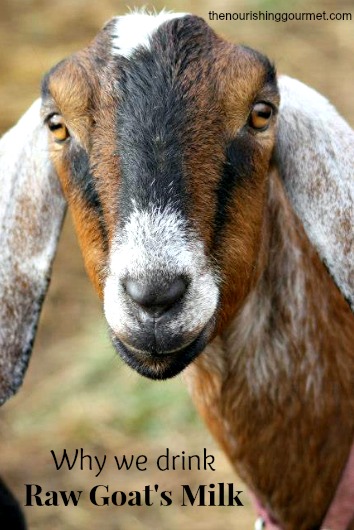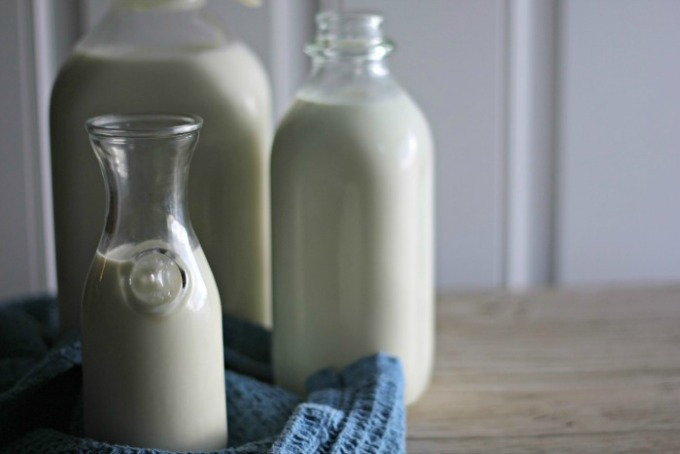by Lindsey Proctor, contributing writer
If you’ve been a reader of The Nourishing Gourmet and other like-minded real food blogs for any length of time, then you’re probably aware that we real foodies are huge supporters of raw milk for those of us who choose to and are able to consume dairy products. The Weston A. Price Foundation refers to it as “real milk” and I think that’s a great term for it. Raw milk is full of real, nourishing enzymes and good bacteria, which are destroyed by the pasteurization process. Kimi’s post discussing raw milk’s benefits and safety is a great read if you’re looking for more information on raw milk in general, as well as the Weston A. Price Foundation’s Real Milk website.
(Kimi notes: The topic of raw milk safety is a broad topic that families should definitely research well – and my views have become more rounded out since I wrote the article linked to above – so that they can make a informed decision. A couple other resources include this book on raw milk #affiliate, and the following articles: Not all raw milk is equal , New Study shows raw milk a low-risk food , Is Raw Milk Safe?. And, on the other side of this issue, Raw Milk Outbreaks really do happen and Raw Milk: A Mother’s Story. Be informed.)
Here at Hickory Cove Farm, we drink lots and lots of raw goat’s milk! Why? Well the simple, honest answer to that is – we raise dairy goats! With their small size and huge personalities, the goats have become a much loved part of our homestead. We got our start in the goat world after Dad came home from a friend’s house one night after trying a glass of milk from their goats. He liked it so much, he decided we needed to get a few goats of our own, and so after some discussion, planning, and research, we did. I’ll never forget that first morning milking and the time spent waiting for the first quart of milk to chill so we could taste it. From the very first sip, we all loved the creamy, nutritious milk they gave us.
When we bought our goats we were given a flyer from the farm we purchased our lovely ladies from, and on it was a short list of the benefits of goat’s milk. When we became members of the American Dairy Goat Association, our welcome packet included more information on the same, and when my sister decided to do a term paper on the benefits of raw goat’s milk, we were made even more aware of what a good choice we’d made when we brought home those two Alpine does that day in August.

Did you know that an average of 65% of the world’s population drinks goat’s milk? It’s true! Goat’s milk is the most popular dairy choice in several countries, and it’s growing in popularity in places like the United States. So, what makes goat’s milk so great? Glad you asked!
Digestibility
According to several sources, goat’s milk takes only 30 minutes at the most to digest, compared to 2 hours or more for cow’s milk. The main reason for this is that the fat globules in goat’s milk are much smaller – about one-fifth the size of those found in cow’s milk. In addition to being smaller in size, there are more short-chain fatty acids than in cow’s milk. All of this contributes to the natural homogenization of goat’s milk.
Vitamins and Minerals
There are several comparison charts available on the internet, such as this one from Fiasco Farm, that show the vitamin, mineral, and fat content of goat, cow, and human milks, and if you’re wanting to see where sheep’s milk falls in there, the chart in this .pdf file also includes that. You’ll notice that goat’s milk is higher in several key vitamins and minerals than the milk from our bovine friends. Of course, this depends somewhat on the goat’s diet and overall health, but milk from a healthy animal is healthy for you! It is good to note that goat’s milk is lacking in folic acid, so if you’re using it to make formula for a young child, or if you choose to consume raw goat’s milk while pregnant, be aware that you should be supplementing with some other form of folic acid.
Less Lactose
My mother and sister both have a lactose intolerance, and they’ve both found that they can drink raw goat’s milk with no adverse affects, but cow’s milk, even raw, gives them stomachaches. Though the lactose content in goat’s milk is only slightly lower than cow’s milk – 4.1% and 4.7%, respectively – it’s enough to make a difference for some people.
Alkalinity
Have you ever heard that you shouldn’t drink milk when you have a cold? Do you find that milk increases the production of mucous in your body? This article by Dr. Mercola does a good job of explaining how some cow’s milk contains a protein that can stimulate your mucous glands and cause excess mucous production. Goat’s milk, however, is an alkaline-forming food, so it helps keep the pH level of your body at the proper level. It also acts as an antacid if you have a problem with too much acid in your digestive system or get an occasional bout of heartburn, acid reflux, or other related digestive issues.
…and finally
A personal opinion that I really don’t have much scientific evidence to back up! While it’s been well-documented that goat’s milk is the most comparable to human milk, and it’s often used to raise orphaned animals of any species, I feel as if the comparable size of goats to humans is a clue as to why goat’s milk is a good choice for me. A standard-size breed, such as the Alpines and Nubians we raise, gives birth to kids that are in the 6-9 lb range, which is also the average weight range for a human baby. An adult standard-size doe averages between 120-150 lbs, while an adult standard-size buck weighs 150-200 lbs, which is again very comparable to the average weights of adult humans. By contrast, the average birth weight of a calf is 80 lbs, an adult cow averages 1000-1300 lbs, and an adult bull can tip the scales at a whopping 3000 lbs! In my mind – cow’s milk is meant to grow ’em real big! And goats – well, they don’t grow quite so large. Like I said, I’ve not found any real evidence to back up that theory, but it makes a lot of sense in my mind.
What about you? Do you drink goat’s milk, or have you in the past? And if you want to try it and aren’t sure where to find it, the Real Milk Finder is a great place to start!

